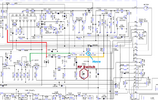Can you supply a better photo of the areas you circled?
Reasoning - when the AM mode is engaged, the IF doesn't stop - the line from the SSB side - still can produce a signal that swamps out AM - so the issue may not be the detector diodes directly - but thru the RF switch used to kill the IF present on the line when the AM system is detecting.

When you switch to AM mode two things are happening - 1st the TR23 is tuning on grounding your detector diodes to make the detector work.
But is the AF detected - able to get thru to the AF preamp?
But the IF signal present is needing to be switched off - so they apply 8V to a bias line and that Diode I see - but need a better photo of, that diode may be the one you're having issues with that needs replacing - the diodes BANDED end goes to ground - that is your RF switch to turn off the IF present so the AM detected signal can pass thru.
If you can bear some more ramblings...
One of many conditions I see in these older radios are when the caps that are in the PICO-farads - even the small stuff, can blow and fail on you - even to the point where - can it even be measured?
So what I've done is simply test lead the ohmmeter to the V x 20 setting and see if the AF preamp is getting proper bias - if it's over 3V on the base - you might have a leaky cap - easier to just replace these up to the AF preamp so you can sleep better at night.
Sometimes the bias is spot on, so what else can go wrong - the RF switch? Maybe - it's been known - but then too, caps can fail open and leaky and you'd not know it until you replace it. Same applies to the diodes use to steer current - but you'd also see that affecting the AF preamps bias from too much signal or too much bias - either way - it pinches off the amp - no audio can get amped.



